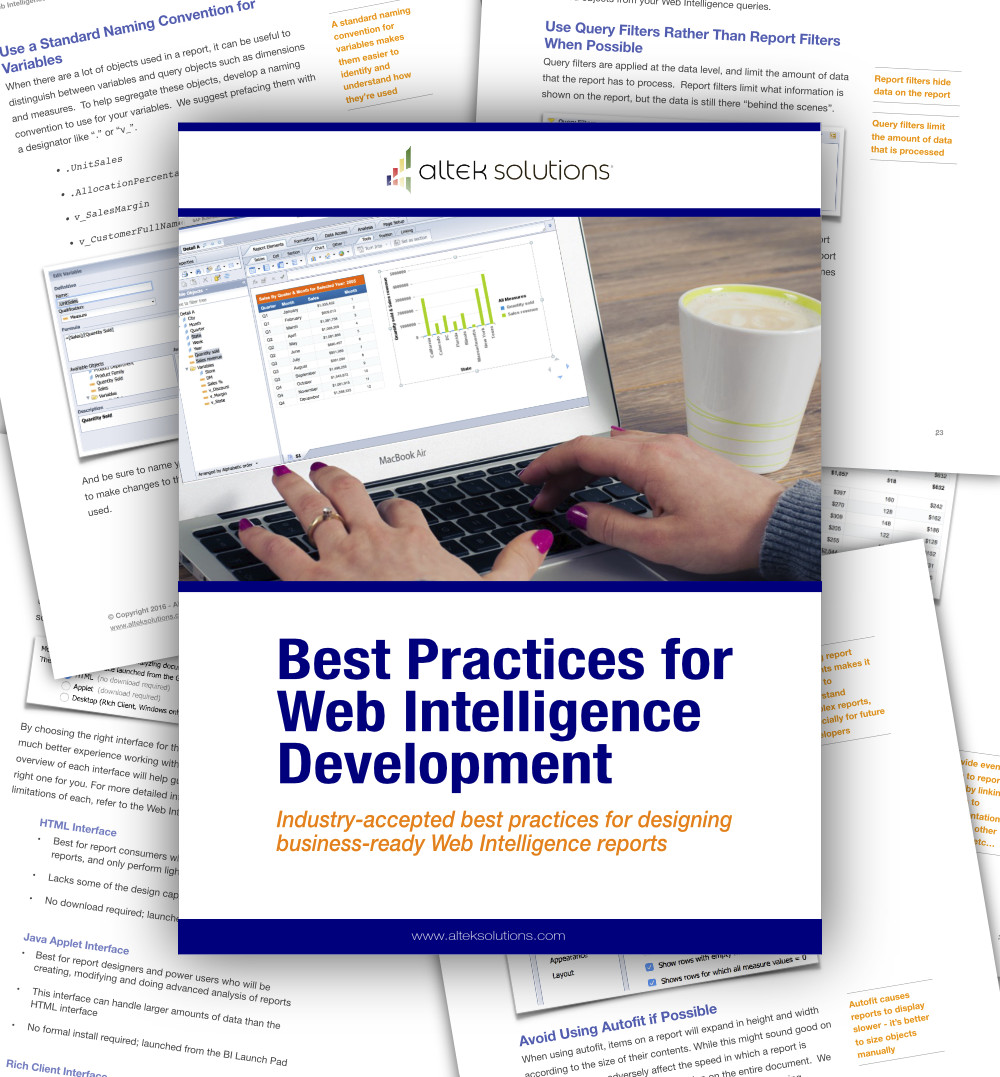This course curriculum is also available as a self-paced, online course.
With our online Web Intelligence Report Development course, you'll get "forever access" to course lectures and exercises that reinforce topics using real-world examples and scenarios. Plus you can progress through the course at your own pace, and utilize it as a job aid for developing reports in your own environment.
Learn more about our online Web Intelligence courseThis course is designed to give you the comprehensive skills and in-depth knowledge needed to access, analyze and share data using SAP BusinessObjects BI launch pad and SAP BusinessObjects Web Intelligence. You will learn how to create Web Intelligence documents for your reporting needs, to retrieve data by building queries using SAP BusinessObjects universes and to use Web Intelligence to enhance documents for easier analysis. You’ll also learn how to organize, manage and distribute documents using the BI launch pad.
Audience
- Report Developers
- Anyone needing to access information and create reports with SAP BusinessObjects Web Intelligence
Prerequisites
- None
What you Will Learn
- Web Intelligence
- Describing Web Intelligence Concepts
- Explaining Web Intelligence Core Functions
- Web Intelligence Documentation Management
- Describing Web Intelligence and the SAP BusinessObjects Business Intelligence Platform
- Logging In to the BI Launch Pad
- Viewing a Web Intelligence Document in the BI Launch Pad
- Sharing Web Intelligence Documents
- Setting BI Launch Pad Preferences
- Logging Off From the BI Launch Pad
- Publishing Documents to the Corporate Repository
- Managing Documents in BI Launch Pad
- Web Intelligence Documents with Queries
- Creating Queries
- Creating a Document
- Modifying a Document’s Query
- Query Properties
- Data Return Restrictions from Queries
- Restricting Data with Query Filters
- Modifying a Query with a Predefined Query Filter
- Applying a Single-Value Query Filter
- Using Wildcards in Query Filters
- Using Prompts to Restrict Data
- Using Complex Filters
- Web Intelligence Document Design
- Modifying Web Intelligence Documents
- Displaying Data in Tables
- Using Tables
- Presenting Data in Free-standing Cells
- Presenting Data in Charts
- Presentation of Data in Documents
- Using Breaks and Calculations
- Using Sorts and Hiding Data
- Formatting Breaks and Cross Tables
- Filtering Report Data
- Ranking Data
- Highlighting Information with Formatting Rules
- Organizing a Report into Sections
- Web Intelligence Document Formatting
- Formatting Documents
- Formatting Charts
- Data Calculation
- Applying Formulas and Variables
- Using Formulas and Variables
- Drilling Functionality
- Analyzing the Data Cube
- Drilling in a Web Intelligence Document
- Comparing the Web Intelligence Clients
- Comparing the Web Intelligence Clients
- Multiple Data Sources
- Synchronizing Data from Multiple Data Sources
- Creating Multiple Queries in a Document
- Synchronizing Data with Merged Dimensions
- Interacting with Other Data Providers
- Advanced Query Techniques
- Implementing Combined Queries
- Implementing Subqueries
- Creating a Query Based on Another Query
- Calculation Contexts
- Describing Calculation Contexts
- Redefining Calculation Contexts
- Implementing Extended Syntax Operators
- Implementing Extended Syntax Keywords
- Defining Calculation Context
- Formulas with Character and Date String Functions
- Creating Formulas with Character and Date String Functions
- Implementing the Right() Function
- Implementing the Replace() Function
- Implementing the SubStr() Function
- Implementing the Pos() Function
- Concatenating Character Strings
- Implementing Date Functions
- If Logic
- Group Data
- Executing the If() Function to Modify Calculation Behavior
- Additional Reporting Techniques
- Implementing Data Tracking
- Implementing Additional Report Functions
- Publishing Web Intelligence Content to Mobile Devices
- Link Options in Web Intelligence Documents
- Managing Links in Web Intelligence Documents
- Using Element Linking to Filter Data
- Managing Hyperlinks in the Web Intelligence Interactive Panel

